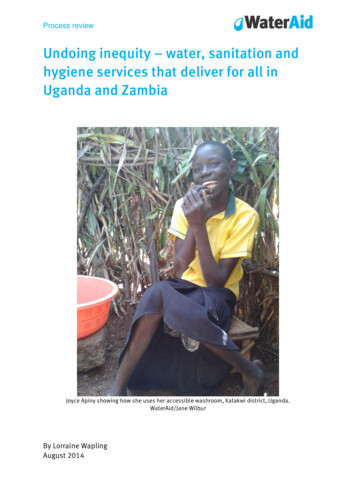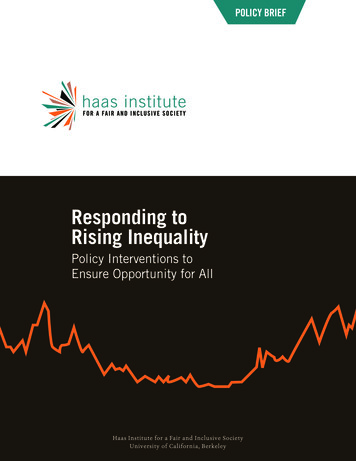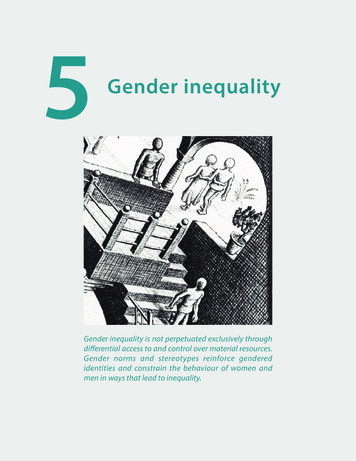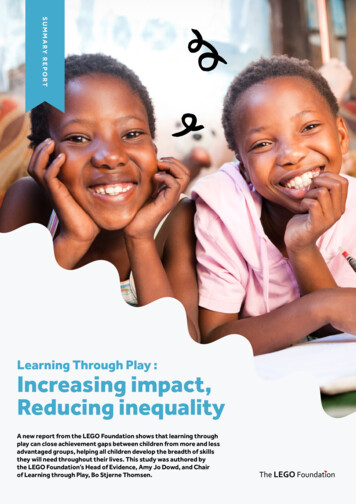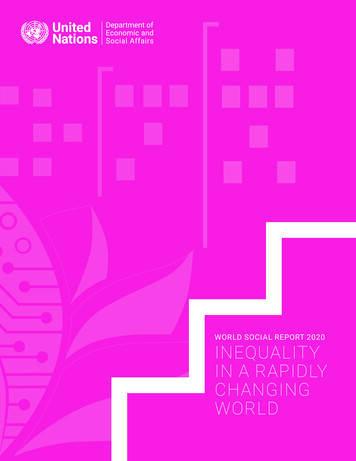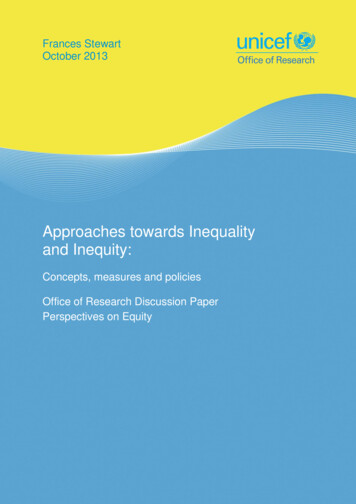
Transcription
Approaches towards Inequality and Inequity: Concepts, measures and policiesFrances StewartOctober 2013Approaches towards Inequalityand Inequity:Concepts, measures and policiesOffice of Research Discussion PaperPerspectives on Equity
Approaches towards Inequality and Inequity: Concepts, measures and policiesOffice of Research Discussion PapersDiscussion Papers are signed pieces by experts and researchers oncurrent topics in social and economic policy and the realization ofchildren's rights.In the Discussion Papers sub-titled “Perspectives on Equity”, theUNICEF Office of Research has invited renowned researchers toshare their insights and viewpoints on equity from different angles.The aim is to encourage reflection, discussion and to inspire, ratherthan to establish or to reinforce any corporate positions on thematter.The findings, interpretations and conclusions expressed in thispaper are those of the authors and do not necessarily reflect thepolicies or views of the United Nations Children’s Fund (UNICEF).Extracts from this publication may be freely reproduced with dueacknowledgement. Requests to utilize larger portions or the fullpublication should be addressed to the Communication Unit atflorence@unicef.org.This is a peer reviewed series.For readers wishing to cite this document we suggest the followingform:Stewart, F. (2013). Approaches towards Inequality and Inequity:Concepts, measures and policies, Office of Research DiscussionPaper No.2013-01, UNICEF Office of Research, Florence. 2013 United Nations Children’s Fund (UNICEF)
Approaches towards Inequality and Inequity: Concepts, measures and policiesThe UNICEF Office of ResearchThe prime objectives of the Office of Research are to improveinternational understanding of issues relating to children’s rights and tohelp facilitate full implementation of the Convention on the Rights of theChild in developing, middle-income and industrialized countries.The Office aims to set out a comprehensive framework for research andknowledge within UNICEF in support of its global programmes andpolicies. Through strengthening research partnerships with leadingacademic institutions and development networks in both the North andSouth, the Office seeks to leverage additional resources and influenceprogrammes, policy and advocacy in favour of children.For further information and to download or order this and otherpublications, please visit the website at www.unicef-irc.org.Correspondence should be addressed to:UNICEF Office of Research - InnocentiPiazza SS. Annunziata, 1250122 Florence, ItalyTel: ( 39) 055 20 330Fax: ( 39) 055 2033 220florence@unicef.orgwww.unicef-irc.org
Approaches towards Inequality and Inequity: Concepts, measures and policiesApproaches towards Inequality and Inequity: Concepts,measures and policiesFrances StewartProfessor of Development Economics and Director of the Centre forResearch on Inequality, Human Security and Ethnicity, University ofOxfordAbstractInequality, in various forms, is a major source of injustice, a cause ofpoverty, and sometimes of conflict. Children are often the victims. Thispaper analyses the different concepts of inequality, in particulardifferentiating individual, or vertical, and group, or horizontal, inequality,and adopting a plural approach to inequality, which involves movingbeyond income to include some basic capabilities such as health,education and nutrition, and also inequalities in political power andcultural status. The paper discusses what a fair, or equitable, distributionis, drawing on some contributions of Western philosophers andeconomists. After reviewing different approaches, it argues that inequalityamong groups is particularly unjust. The paper argues for a pluralperspective on the space in which inequality is assessed, following Sen’scapability approach. Special attention needs to be given to thosecapabilities which affect people’s basic life chances, including health,education and nutrition. It is argued that the assessment should relate tofunctionings (or outcomes) rather than capabilities (or possibilities),especially for children whose choices are severely constrained. The paperincludes suggestions for identifying relevant categories for measurementof horizontal inequality (HI) in particular situations and makes someproposals for the type of measurement that is appropriate. It concludeswith some suggestions for UNICEF activities and for research in this area.The approach suggested in the paper – with a focus on group inequalitiesand on plurality of assessments – is broadly consistent with UNICEF’sexisting approaches to these issues.KeywordsInequality, inequity, poverty, human rights, UNICEF, indicators.AcknowledgementsI am grateful for very helpful comments on the first draft of this paperfrom members of the team at Innocenti and an anonymous referee.4
Approaches towards Inequality and Inequity: Concepts, measures and policiesTable of Contents1. Introduction62. Concepts and Definitions62.1 Among whom?2.2 Which groups2.3 Inequality of what, or in what space?2.4 Over what time?2.5 Summary of conclusions on defining inequality78813143. Issues of Justice154. Instrumental Reasons for Concern with Income Inequality234.1 Growth of incomes4.2 Inequality and poverty4.3 Inequality, education, health and nutrition4.4 Some evidence of the links4.5 Inequality and crime4.6 Inequality and conflict2324252628285. Measurement5.1 Vertical inequality5.2 Horizontal inequality2930316. Appropriate Indicators367. UNICEF’s Role377.1 Mapping inequality/inequity7.2 Monitoring7.3 Advocacy7.4 Projects8. Does this Agenda Depart from Current UNICEF Policies?8.1 Definition of equity8.2 What are the basic dimensions?8.3 Mapping8.4 Situation analyses3738383940404141419. Conclusion42Appendix44References455
Approaches towards Inequality and Inequity: Concepts, measures and policiesWhichever way we look at it, we always return to the same conclusion: namely that thesocial pact establishes equality among the citizens in that they all pledge themselves underthe same conditions and all enjoy the same rights.Rousseau 1968 (first edition 1762): 761. IntroductionThis paper is concerned with the issue of equality and equity, with aparticular focus on children and other vulnerable groups. It aims toreview normative issues: should we aim for equality? What is a fairor equitable distribution? And also to consider more practicalquestions: how should we interpret any conclusions about equalityand equity in practice? What does this mean for data collection andmeasurement? What are the policy implications in general, and inparticular for UNICEF, especially in relation to children andvulnerable groups.To discuss these issues, it is necessary to start with some conceptualclarifications concerning the two key concepts – equality and equity.This forms section I of the paper. Section 2 discusses the normativequestions – what is a just and equitable distribution – drawing onthe arguments of some philosophers and economists. The issue ofdistribution is not only a normative one, but also instrumental: howdoes inequality affect other valued objectives? A brief survey of thisissue is covered in section 3. Section 4 discusses relevant measuresof inequality, while section 5 considers which indicators areappropriate. Section 6 comments on UNICEF’s role, and section 7concludes with a summary of recommendations and somesuggestions for future research.2. Concepts and definitionsFirst, we need to clarify the distinction between ‘equality’ and‘equity’. ‘Equality’ implies treating people as equal in some respect(how this is to be interpreted is discussed later in this section). Onceone has decided on the interpretation, whether equality has beenachieved and – if not – the extent of inequality, is an empiricalquestion. An ‘equitable’ distribution, in contrast, is one that isconsidered to be ‘fair’ - therefore an equitable distribution is the onewe should aim for. Deciding what is an equitable distribution thusinvolves a value judgement, on which there can be disagreement. Anequitable distribution need not be an equal distribution – fair sharesare not necessarily equal shares. Because of this element ofjudgement in ‘equity’ it is a rather slippery term: what the WorldBank, for example, means by equity could be very different from theperception of UNICEF. Indeed, section 2 of this paper reviews arange of judgements about the extent of equality that is desirable –or what an equitable distribution would be. Consequently, while this6
Approaches towards Inequality and Inequity: Concepts, measures and policiespaper aims to come to some conclusions about equity, to underpinUNICEF actions, most of the discussion is in terms of equality andinequality.There are a variety of ways that ‘equity’ could be determined foroperational purposes. In Section 2 I consider insights from somephilosophers and economists on the issue of what is a just (orequitable) distribution. This is intended to provide some guidance.Views of what is equitable have evolved historically and are stillevolving. Any institution aiming for an equitable distribution mustcome to its own judgement on these issues, drawing on generalarguments such as those put forward in this paper, commonperceptions and its own concerns (for example, UNICEF is clearlyparticularly concerned with treating children equitably).When it comes to assessing the extent of inequality, and deciding onan equitable distribution, certain critical definitional issues need tobe considered, including distribution among whom; if amonggroups, which groups; in what space the distribution is assessed;and over what time. These issues are considered below.2.1Among whom?Distribution can be assessed among individuals or householdswithin a society; among individuals or households in a region,continent, or the world; among nations; and among groups, within aparticular society, or in the world as a whole. In this paper, I shallfocus on particular societies, and thus not consider issues of globaldistribution or global justice. In the majority of analyses andmeasures of distribution, the focus is on individuals or households,often measuring this by the well known Gini coefficient. For exampleonly individual/household distribution is reported on in the widelyused World Development Indicators. I shall term this verticalinequality (VI) to differentiate it from inequality among groups,which I define as horizontal inequality (HI). Since children andwomen each constitute groups, and since the greatest deprivation isto be found among women and children in minority ethnic groups,HI is especially relevant to UNICEF. However, VI clearly matterstoo: in particular, for UNICEF, the major concern is with poorwomen and children. In the section on justice I shall consider bothVI and HI, and argue that stronger conclusions can be drawn aboutan equity distribution for groups than for individuals. Themeasurement and data sections will focus on groups, since measuresof VI are much better developed and known. In the analysis ofcauses and of policy too, I concentrate on groups.7
Approaches towards Inequality and Inequity: Concepts, measures and policies2.2Which groups?Given the focus on HI, the immediate issue is which groups are ofrelevance. People can be grouped according to many characteristics,and most people are members of multiple groups, or have multipleidentities. We are concerned here with groups that have salience topeople and are relevant to policy-making. Age and gender groups fillboth criteria and are especially relevant to UNICEF, as is disability.Ethnicity, race, region and religion are also important categories asthey are often associated with discrimination and deprivation. Whileeach of these groups can be described as ‘socially constructed’ andprecise membership may be somewhat arbitrary and also fluid, inmany societies they form salient political and policy-relevantgroupings. The relevant grouping, however, differs according to thepurpose of the classification and the history of any society. Only anin-depth historical and contemporary analysis can identify theappropriate classification for a given society. The broad categoriesgiven above – age, gender, disability, ethnicity, race, religion, region– provide good starting points everywhere. But some may proveirrelevant in particular places, and how each category is best defined(e.g. which age group; which ethnic or sub-ethnic classification) islikely to vary across countries and over time. However, in practice inparticular societies, the categories associated with historical and/orcontemporary discrimination, and exhibiting major HIs, are usuallyapparent even to a casual observer – for example, religion and castein India, race in Malaysia; ethnicity in many African countries;different religious denominations in Northern Ireland and theMiddle East. Some of the categories overlap (for example, religionand ethnicity quite often largely overlap). People are members ofmultiple groups, and particular combinations of identity can lead tothe worst poverty: for example, in Peru indigenous, rural womensuffer from treble discrimination – from being indigenous, beingrural, and being women (Barrón Ayllón 2005).2.3Inequality of what, or in what space?This is a question which has been subject to a great deal of debateand is critically important for questions of equity and policy(Williams 1962; Sen 1980; Dworkin 1981; Cohen 1989; Arneson1997; Roemer 1998; Anderson 1999). The issue applies equally toboth vertical and horizontal distribution.Two important questions arise: first, whether the appropriatemeasure of inequality is in terms of incomes or resources or shouldextend to some broader measure of welfare; and, secondly, whetherthe measure should be one of outcomes or opportunities foroutcomes, allowing for individual variations in the translation ofopportunities (however assessed) to outcomes.8
Approaches towards Inequality and Inequity: Concepts, measures and policiesEconomists have tended to define inequality in terms of moneyincomes, this being supposedly a measure of inequality in utility oreconomic welfare. However, some have rejected this measure ofeconomic outcomes, and advocated a measure of inequality ineconomic opportunities (Roemer 1998; World Bank 2006; Paes deBarros, Ferreira et al. 2009). The latter may be defined narrowly asconsisting of children and adults, of equal capacity andqualifications, having the same opportunities to succeed (get aschool place; get a job; earn a particular income). But this is a verynarrow interpretation, neglecting the many dimensions of people’scircumstances that affect capacity and qualifications themselves aswell as their opportunities and well-being. Equality of opportunitiescan be defined more radically as a situation in which ‘morallyirrelevant pre-determined circumstances, such as race, gender, placeof birth, and family background’ do not affect outcomes (Paes deBarros, Ferreira et al. 2009). The former definition can be consistentwith considerable HIs, since deprived groups generally lackqualifications. But the latter rules out much HI, since most groupinequalities do indeed reflect and are the consequence of such predetermined circumstances.Adopting an income or resources metric has been widely criticisedas involving a narrow view of well-being and a number ofalternatives have been suggested (Seers 1972; Morris 1977; Sen 1977;Hicks and Streeten 1979). Sen has advocated a much broadermeasure encompassing people’s capabilities or freedoms, i.e. all thethings that people can be or do. In focussing on a range ofcapabilities, Sen abandoned the money metric of incomes andmoved to a plural assessment of well-being and inequality; and byfocussing on capabilities, he also advocated opportunities ratherthan outcomes as the space for assessing inequality.According to the capability approach, incomes remain important asthey help determine what people can be or do; but there are manyother factors besides incomes that are relevant to this, including theavailability of public services, the extent and nature of civil society, aperson’s own characteristics, and so on. Thus incomes are not agood measure of the totality of capabilities. Within the capability set,people actually choose only a subset of things to do or be, which Sendefines as functionings. In some respects functionings are a moreuseful space for assessing inequality than capabilities – first,because they can be much more readily observed than capabilities;and secondly, for children especially, the freedom to make choices isheavily constrained so that functionings may indeed be a goodindicator of capabilities. However, we should recognise that thedistribution of functionings does not represent the full set ofcapabilities, and we could come to wrong conclusions about thedistribution of capabilities on the basis of observed functionings.9
Approaches towards Inequality and Inequity: Concepts, measures and policiesFor example, a person may appear very undernourished and poorlyclothed and yet in reality be a rich miser, or an opulent ascetic.1 Thisdivergence between capabilities and functionings is less likely whenit comes to group inequalities because it is less likely that there aresystematic differences in the move from capabilities to functioningsfor a group as a whole, than for particular individuals.There are a vast range of capabilities (and functionings). It isdesirable to pick out a subset for assessment, first because some arequite trivial so that inequality in their distribution is alsounimportant – for example, in the capability (or functioning) ofjuggling; and secondly, because there may be differences in thedistribution of particular capabilities among individuals, reflectingdiffering personal characteristics; and when it comes to functioningthere may be further differences in distribution among individualsacross functionings reflecting choices (e.g. those who have chosen tobecome musicians may not have time also to be good at sports; thosewho have spent a lot of money on improving their house may not beable to spend so much on dressing well as someone else with thesame capability set who has made different choices). The questionthen is how to pick out the critical capabilities to form the basis forassessments of distributional equity.One way, advocated by Anderson (1999), is to include thosecapabilities which are necessary for people to be treated as of equalmoral worth. According to her, this requires ‘effective access tolevels of functioning sufficient to stand as an equal in society’ over aperson’s entire life (Anderson: 318). She argues that this does notnecessarily involve complete equality but sufficient access to goodsnecessary for equality of respect which would vary across societiesbut would certainly involve minimum levels of some basic things,such as access to education and nutrition. While potentially, the ideaof seeking equality of respect could form the basis of judgements,the selection of capabilities and the level of access required remainsquite subjective. It could be interpreted rather minimally asequivalent to a basic needs approach – which would be consistentwith considerable inequality in relation to non-basic needs, goodsand services. Or it could be interpreted in a much more egalitarianway in capability or functioning space. Another approach is to selectthose capabilities which are of foundational importance, in the sensethat they are necessary if other capabilities are to be realized.Health, nutrition and education, and access to other resources whichmay be essential for livelihood, such as transport, could come in thisThere is a parallel here with the revealed preference approach to assessing welfare – see Little, I. M. D. (1957). A critique ofwelfare economics, Oxford, Clarendon Press. This approach assumes that choices a person makes (revealed preference) willmaximise their welfare. Yet these choices are distorted by income distribution, advertising and social pressures, and anindividual’s inability to express a preference through their consumption decisions for socially provided goods. Hence theactual outcome is far from representing a welfare maximum and even further from maximising a broader concept of wellbeing.110
Approaches towards Inequality and Inequity: Concepts, measures and policiescategory. Monetary incomes could also be included to encompassthe many missing dimensions.There are also important dimensions of life beyond the socioeconomic, which are of especial relevance to HIs. In particular,inequalities in cultural recognition and respect are important for thewell-being and dignity of cultural and religious minorities, as well asin determining the ability of people from such minorities to functioneffectively. For example, failure to recognise minority languages canhandicap people in terms of jobs and incomes. Further politicalinequalities can be the source of many other inequalities. Lack ofadequate representation in political bodies can lead to policy biasesand discrimination as well as to lack of self-respect; while lack ofcitizenship often debars people from many other entitlements(Gibney 2008). Inequalities in cultural recognition, by definition,relate to groups since cultural practices (religion, cultural norms,language, etc.) pertain to groups, though of course they affectindividuals within groups. Inequalities in political power can also beargued to be more relevant to groups rather than individuals, sinceindividuals mainly exercise political power through grouporganization and representation. However, ‘empowerment’ is oftenattributed to individuals and since political power/influence variessharply across groups and classes, in principle one could arrive atsome assessment of its distribution among individuals.2Adopting a plural approach to inequality, encompassing a number ofimportant dimensions, raises the question of whether to develop anaggregate indicator, incorporating all dimensions. Any suchaggregation requires some weighting among the indicators. Yet bytheir nature the plural dimensions are incommensurate, especiallyacross broad dimensions, such as political, cultural and socioeconomic categories. Weighting implies some trade-off among thedimensions – yet is it possible to weight an improved situation vis-àvis health against a worsened situation politically? Any aggregationis therefore likely to be somewhat arbitrary and to conceal importantinformation. However, aggregation within each of the broadcategories may be helpful to get an overall picture of the situation.In relation to the space or dimension of inequality, I conclude that:(i)incomes are an inadequate space for the assessment ofinequality, whether VI or HI, which should incorporatesocio-economic, political and cultural recognitiondimensions;Very little work has been done on assessing inequalities in political power – more on HIs than VI. See Stewart, F. (2011)."Inequality in Political Power: A Fundamental (and Overlooked) Dimension of Inequality." European Journal ofDevelopment Research: 23.211
Approaches towards Inequality and Inequity: Concepts, measures and policies(ii)the capabilities approach of Sen provides a good theoreticalunderpinning which, by focussing on capabilities oropportunities rather than outcomes, leaves room forindividual agency; but for measurement purposes it isfunctionings rather than capabilities which should normallybe assessed;(iii)that within the large range of potential functionings, a subsetof foundational ones should be chosen, including access tohealth services and health outcomes; nutrition; educationalaccess and outcomes; others may be selected according toimportance and data availability in particular countries, butincomes (and income distribution) provide a usefulsupplement to represent many functionings which have notbeen included in the proposed list of critical functionings;(iv)for groups a special effort should be made to assessinequalities in political power and cultural recognition;(v)aggregation into a single indicator is not desirable acrossbroad categories, but may be useful within categories.UNICEF’s focus on children and women suggests that there shouldbe a selection of functionings (and underpinnings of these)especially relevant to women and children, including:for womena. health services relevant to the needs of women (maternity care)b. women’s educational levels and their access to adult educationc. relative male/female rates of abuse (assault; homicide)d. an assessment of female political power, relative to men, at alllevels (cabinet, parliament, local government, different levels ofthe civil service)for childrena. health care for children, including immunisation, nutritionmonitoring etc.b. rates of child abusec. rates of homelessness among children.For both women and children, hidden constraints on their freedomof choice make functionings a more appropriate space thancapabilities. It must be emphasized that neither women nor childrenlive as isolated individuals but are firmly embedded in households.12
Approaches towards Inequality and Inequity: Concepts, measures and policiesConsequently, the situation of the household is relevant to theirposition, so general inequalities facing households (including forexample, male access to jobs) are relevant as well as the special onesobserved for the group. In particular, the most deprived women andchildren are typically those in the worst off segments of the mostdisadvantaged racial/religious/ethnic or regional groups. This thenrequires identification of HIs among these identity groups;identification of the worst off households within the worst offidentity group(s); and the intra-household distribution offunctionings within the most deprived households.2.4Over what time?Clearly if inequality fluctuates a lot, then one needs to measure itover several years to get a true picture of the distribution ofcapabilities. The nature and extent of injustice and the societalconsequences of inequality are very different if particular individualsmove in and out of poverty or riches than if everyone stays in thesame place in the hierarchy. Yet data on societal inequality does notgive any information on what happens to particular individuals –only on the distribution as a whole. Panel data would be necessary(and desirable) to inform us about whether a stable overalldistribution is indicative of stability in the placement of particularindividuals. The limited evidence available, which relates tomovement in and out of poverty, indicates that many individuals domove in and out of poverty – for example, a study showed that in theCentral and Western Regions of Uganda nearly a quarter ofhouseholds moved out of income poverty over a 25-year period(Krishna 2005).3However, for horizontal inequality we are not concerned with whathappens to individuals but rather the group as a whole.Consequently, measurement of group performance over time will besufficient to give an indication of longer-term inequalities. HIsbetween ethnic, racial and gender groups often (but not always)persist over decades and even centuries (Stewart and Langer 2008;Thorp and Paredes 2010). Tilly defined such ‘durable’ inequality ascategorical inequality and provided an explanation of why suchinequality tends to persist in terms of opportunities, exploitation,emulation and adaptation – i.e. a group which gets an initialadvantage (opportunity) exploits and sustains this advantage inwhatever way it can (e.g. by exclusion and discrimination) and thisis widely imitated (Tilly 1998). An additional explanation is that aninitial advantage becomes cumulative (e.g. extra income enablesextra health and education in the next generation which then leadsIn Europe it has been argued that extensive mobility moved ‘virtually all families to relative deprivation at leastoccasionally’ (Duncan, G. J. et al. (1993). "Poverty dynamics in eight countries." Journal of Population Economics 6(215234): 215.313
Approaches towards Inequality and Inequity: Concepts, measures and policiesto extra incomes). While such cumulative factors apply toindividuals, among groups the forces of persistence tend to begreater as they lead to asymmetries of social capital (groups havingmore contacts with other members of the same group than withoutsiders) and this is compounded by overt discrimination (Stewartand Langer 2008). Panel studies have shown that individualmobility is greater for people in more advantaged groups than forthose in disadvantaged groups (Devine, Plunkett et al. 1992; Duncan1993; Corcoran 1995). For example, in Brazil, income persistencehas been shown to be greater among Afro-descendants than the restof the population (Ferreira and Veloso 2004) cited in (Paes deBarros, Ferreira et al. 2009). Consequently, the likelihood of movingin and out of poverty (and riches) is greater for members of anadvantaged group, and members of the disadvanataged group aremore likely to be stuck in their lowly position.4 Consequently,horizontal inequalities are in some ways worse than vertical becausethe likelihood of persistent deprivation – for members of deprivedgroups – is greater. Generally, inequality needs to be measured overtime to understand its full welfare implications.2.5Summary of conclusions on defining inequalityTo summarise, inequality and distributional issues can relate todistribution among individuals, among groups within a country, oracross nations. Here the discussion of inequality is confined toindividuals and groups, the former being termed vertical inequalityand the latter horizontal inequality. Considerations of the dimensionor space in which to assess distribution and the durability of suchinequality relates both to VI and HI. For both VI and HI, a broaderapproach is desirable than provided by the distribution of income.Sen’s capability approach provide
Approaches towards Inequality and Inequity: Concepts, measures and policies 6 Whichever way we look at it, we always return to the same conclusion: namely that the

